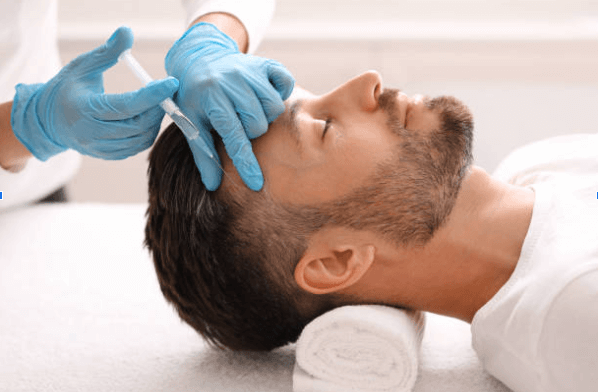Looking to the Future: The Potential of PRP and Its Role in Hair Regrowth
In recent years, Platelet-Rich Plasma (PRP) hair treatment has emerged as a promising solution for individuals grappling with hair loss and thinning. This innovative technique harnesses the body’s natural healing powers to stimulate hair follicles and promote hair regrowth. As we look to the future, PRP hair treatment holds tremendous potential in revolutionising the field of hair restoration.
This post looks into the science behind PRP therapy, its applications, its efficacy, and the exciting possibilities it presents for the future of hair regrowth.
Understanding PRP Hair Treatment
Platelet-Rich Plasma (PRP) therapy is a minimally invasive medical procedure that uses a patient’s own blood to promote healing and regeneration. It has gained widespread recognition and adoption in various medical disciplines, including orthopaedics, dermatology, and sports medicine. The fundamental principle behind PRP therapy is the concentration of platelets, which are rich in growth factors, within the patient’s blood.
The PRP procedure typically involves the following steps:
1. Blood Collection: A small sample of the patient’s blood is drawn, usually from their arm.
2. Centrifugation: The blood sample is then processed in a centrifuge machine, which separates the platelet-rich plasma from the other components of the blood.
3. Activation: The PRP is sometimes activated using calcium chloride or other substances, which releases growth factors from the platelets.
4. Injection or Topical Application: The PRP is injected directly into the target area or applied topically, depending on the specific medical application.
PRP’s Role in Hair Regrowth
Hair loss, a condition that affects millions of people worldwide, can have a profound impact on an individual’s self-esteem and quality of life. PRP hair treatment has emerged as a promising solution for those seeking to combat hair loss without resorting to surgical procedures or pharmaceuticals. The treatment’s success in hair regrowth is attributed to its ability to stimulate the dormant hair follicles and promote a conducive environment for hair growth.
Here’s how PRP works in the context of hair regrowth:
1. Hair Follicle Stimulation: PRP is rich in growth factors such as platelet-derived growth factor (PDGF), transforming growth factor-beta (TGF-β), and vascular endothelial growth factor (VEGF). When injected into the scalp, these growth factors stimulate the hair follicles, encouraging them to transition from the dormant phase (telogen) to the active growth phase (anagen).
2. Improved Blood Circulation: PRP injections enhance blood flow to the hair follicles, ensuring they receive a rich supply of nutrients and oxygen. This improved circulation nourishes the follicles, making them more conducive to hair growth.
3. Reduction in Inflammation: Chronic inflammation of the scalp can contribute to hair loss. PRP therapy has anti-inflammatory properties that help reduce scalp inflammation, creating a healthier environment for hair to grow.
4. Prolonged Anagen Phase: PRP therapy may extend the duration of the anagen phase, during which hair grows actively. This results in thicker, longer-lasting hair.
Current Applications and Efficacy of PRP Hair Treatment
PRP hair treatment is currently used to address a variety of hair loss conditions, including androgenetic alopecia (male and female pattern baldness), alopecia areata, and even hair loss resulting from trauma or surgical procedures. While individual results may vary, many patients have reported significant improvements in hair density and thickness after undergoing PRP therapy.
Clinical studies and anecdotal evidence support the efficacy of PRP hair treatment:
1. Clinical Studies: Several clinical trials have explored the effectiveness of PRP in hair regrowth. A study published in the Journal of Cutaneous and Aesthetic Surgery in 2014 found that PRP injections significantly improved hair density and thickness in individuals with androgenetic alopecia. Similar studies have reported positive outcomes.
2. Patient Satisfaction: Many individuals who have undergone PRP hair treatment report high levels of satisfaction. They often observe visible improvements in hair volume, texture, and overall quality.
3. Minimal Side Effects: PRP therapy is generally well-tolerated, with minimal side effects. Some patients may experience mild swelling or discomfort at the injection site, but these symptoms usually resolve within a few days.
4. Complementary Treatment: PRP therapy can be used in conjunction with other hair restoration treatments, such as hair transplant surgery or topical medications, to enhance results and promote faster healing.
The Future of PRP Hair Treatment
As we look to the future, PRP hair treatment is poised to play an increasingly significant role in the field of hair regrowth. Several factors contribute to the bright outlook for PRP therapy:
1. Ongoing Research: Continued research and clinical trials are likely to refine PRP treatment protocols and enhance its effectiveness. This will provide more tailored and predictable results for patients dealing with various types and stages of hair loss.
2. Advancements in Technology: Technological advancements may lead to the development of more sophisticated PRP preparation methods, ensuring optimal platelet concentration and growth factor activation.
3. Customised Treatment Plans: The future of PRP hair treatment may involve personalised treatment plans based on a patient’s unique genetic makeup and hair loss characteristics. This precision medicine approach could maximise results.
4. Combination Therapies: Combining PRP therapy with other innovative hair restoration techniques, such as stem cell therapy or gene therapy, holds promise for achieving even more remarkable outcomes.
5. Increased Accessibility: As PRP hair treatment gains wider acceptance and becomes more accessible, it has the potential to benefit a broader range of individuals seeking effective solutions for hair loss.
Challenges and Considerations
While the potential of PRP hair treatment is undeniable, it’s essential to acknowledge the challenges and considerations associated with this therapy:
1. Variable Results: PRP treatment outcomes can vary from person to person. Factors like the cause and extent of hair loss, individual response to therapy, and the skill of the administering healthcare provider can influence results.
2. Cost: PRP hair treatment is generally considered a cosmetic procedure and may not be covered by insurance. The cost can vary, depending on the provider and the number of sessions required.
3. Maintenance: To sustain the results of PRP therapy, patients may need periodic maintenance sessions. This ongoing commitment should be considered when choosing PRP as a hair restoration option.
4. Limited Long-Term Data: While short-term studies show promising results, long-term data on the efficacy and safety of PRP hair treatment are still emerging.
Conclusion
PRP hair treatment has emerged as a promising and minimally invasive solution for individuals struggling with hair loss and thinning. Harnessing the regenerative power of platelet-rich plasma, this therapy has demonstrated its ability to stimulate hair follicles, improve blood circulation, and reduce inflammation, ultimately promoting hair regrowth. As we look to the future, PRP therapy holds tremendous potential for further refinement and innovation.
While current evidence supports the efficacy of PRP hair treatment, ongoing research, technological advancements, and personalised treatment approaches are expected to elevate its effectiveness. The future of PRP therapy in hair regrowth is bright, offering hope to those seeking natural and lasting solutions to their hair loss concerns.






